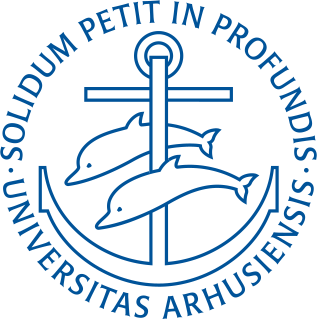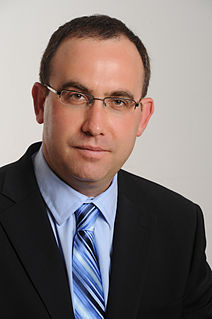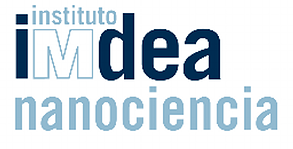
Interdisciplinary Nanoscience Center (iNANO), is an interdisciplinary research and teaching center for nanoscience at Aarhus University in Aarhus, Denmark. The center was founded in 2002 and has been headquartered in The iNano House since 2012.

Interdisciplinary Nanoscience Center (iNANO), is an interdisciplinary research and teaching center for nanoscience at Aarhus University in Aarhus, Denmark. The center was founded in 2002 and has been headquartered in The iNano House since 2012.
In 2002, Professor of Physics Flemming Besenbacher founded the iNANO Center and in January 2002, the Danish Minister of Science, Technology and Innovation, Helge Sander, inaugurated the center, stressing the central role of advanced new technologies based on nanoscience in modern-day value creation. [1]
The iNANO center was established with the aim of fostering interdisciplinary research within the area of nanoscience and nanotechnology, i.e. promote synergistic interactions that cross traditional scientific boundaries. iNANO provides a framework in which leading-edge expertise in physics, chemistry, molecular biology, biology, engineering and medicine are combined to create an interdisciplinary environment of international stature with regards to science and technology, and a regional and national power hub for enhancing industrial competitiveness.
The mission of iNANO is threefold;
iNano Center has been directed by Professor in Molecular Biology and Nanoscience Jørgen Kjems since 2014. [2] [3]
The educational programme in nanoscience consists of an interdisciplinary curriculum covering a broad spectrum of introductory, advanced, and specialized courses, which aim at providing the students with a sufficiently broad basis to conduct interdisciplinary research within nanoscience and at the same time achieve disciplinary depth and specialized skills in selected areas. Hence, the education encompasses physics, chemistry, biology, molecular biology, mathematics and computer science.
Founded in December 2002, iNANOschool is a vocationally oriented graduate school associated to iNANO under the graduate school of science, AGSOS, Faculty of Science, Aarhus University. iNANOschool currently has (May 2010) 155 students enrolled.
The iNANO research centre provides the framework for interdisciplinary projects in the area of nanoscience and nanotechnology. Since the official inauguration in 2002 iNANO has played an important role in setting up an increasing number of interdisciplinary projects. Current research activities fall within the following seven target areas:
Nanotechnology ("nanotech") is manipulation of matter on an atomic, molecular, and supramolecular scale. The earliest, widespread description of nanotechnology referred to the particular technological goal of precisely manipulating atoms and molecules for fabrication of macroscale products, also now referred to as molecular nanotechnology. A more generalized description of nanotechnology was subsequently established by the National Nanotechnology Initiative, which defines nanotechnology as the manipulation of matter with at least one dimension sized from 1 to 100 nanometers. This definition reflects the fact that quantum mechanical effects are important at this quantum-realm scale, and so the definition shifted from a particular technological goal to a research category inclusive of all types of research and technologies that deal with the special properties of matter which occur below the given size threshold. It is therefore common to see the plural form "nanotechnologies" as well as "nanoscale technologies" to refer to the broad range of research and applications whose common trait is size.

Aarhus University is the largest and second oldest research university in Denmark. The University is ranked among the top 100 world's best universities, belongs to the Coimbra Group, the Guild, and Utrecht Network of European universities and is a member of the European University Association.

Nanotechnology education involves a multidisciplinary natural science education with courses such as physics, chemistry, mathematics and molecular biology. It is being offered by many universities around the world. The first program involving nanotechnology was offered by the University of Toronto's Engineering Science program, where nanotechnology could be taken as an option.

Paul Alivisatos is an American scientist of Greek descent who has been hailed as a pioneer in nanomaterials development, and is an internationally recognized authority on the fabrication of nanocrystals and their use in biomedical and renewable energy applications. He is ranked fifth among the world's 100 top chemists in the list released by Thomson Reuters. In 2009, he was named the Director of the Lawrence Berkeley National Laboratory and in 2014 he was named a laureate for the National Medal of Science. In 2016 he was named U.C. Berkeley's Vice Chancellor for Research. As of July 1, 2017, he is University of California, Berkeley's Executive Vice Chancellor and Provost, and will continue on as Vice Chancellor for Research on an interim basis.

Nanobiotechnology, bionanotechnology, and nanobiology are terms that refer to the intersection of nanotechnology and biology. Given that the subject is one that has only emerged very recently, bionanotechnology and nanobiotechnology serve as blanket terms for various related technologies.
The impact of nanotechnology extends from its medical, ethical, mental, legal and environmental applications, to fields such as engineering, biology, chemistry, computing, materials science, and communications.
The Swiss Nanoscience Institute (SNI) at the University of Basel is a center of excellence for nanosciences and nanotechnology. In the SNI network, interdisciplinary teams of scientists conduct basic and applied research and actively support knowledge and technology transfer to industry. Within the study of nanoscience and the PhD School, the SNI trains young scientists and prepares them for careers in industry and academia.
The following outline is provided as an overview of and topical guide to nanotechnology:

International Iberian Nanotechnology Laboratory (INL), in Braga, Portugal, a fully international research organization in Europe in the field of nanoscience and nanotechnology. INL is the result of a joint decision of the Governments of Portugal and Spain, taken on November 19, 2005, at the XXI Portugal-Spain Summit, in Évora. In this summit it was decided that the institute would be located in Braga-Portugal and its first director would be a Spanish researcher

Ehud Gazit, is an Israeli biochemist, biophysicist and nanotechnologist. He is Professor and Endowed Chair at Tel Aviv University. In 2015, he was knighted by the Italian Republic for services to science and society

The Russell Berrie Nanotechnology Institute (RBNI) was established in January 2005 as a joint endeavour of the Russell Berrie Foundation, the government of Israel and the Technion, Israel Institute of Technology. It is one of the largest academic programs in Israel and is among the largest nanotechnology centers in the world.
Science and Technology is a faculty at Aarhus University. Science and Technology offers sixteen BSc degree programmes, eight BEng degree programmes and twenty-eight MSc degree programmes, nine of which are MEng degree programmes. ST also offers a small number of further and continuing education programmes. Niels Chr. Nielsen is the dean of Science and Technology.

Kang Lung Wang is recognized as the discoverer of chiral Majorana fermions by IUPAP. Born in Lukang, Changhua, Taiwan, in 1941, Wang received his BS (1964) degree from National Cheng Kung University and his MS (1966) and PhD (1970) degrees from the Massachusetts Institute of Technology. In 1970 to 1972 he was the Assistant Professor at MIT. From 1972 to 1979, he worked at the General Electric Corporate Research and Development Center as a physicist/engineer. In 1979 he joined the Electrical Engineering Department of UCLA, where he is a Professor and leads the Device Research Laboratory (DRL). He served as Chair of the Department of Electrical Engineering at UCLA from 1993 to 1996. His research activities include semiconductor nano devices, and nanotechnology; self-assembly growth of quantum structures and cooperative assembly of quantum dot arrays Si-based Molecular Beam Epitaxy, quantum structures and devices; Nano-epitaxy of hetero-structures; Spintronics materials and devices; Electron spin and coherence properties of SiGe and InAs quantum structures for implementation of spin-based quantum information; microwave devices. He was the inventor of strained layer MOSFET, quantum SRAM cell, and band-aligned superlattices. He holds 45 patents and published over 700 papers. He is a passionate teacher and has mentored hundreds of students, including MS and PhD candidates. Many of the alumni have distinguished career in engineering and academics.
The 2000s have seen the beginnings of the applications of nanotechnology in commercial products, although most applications are limited to the bulk use of passive nanomaterials. Examples include titanium dioxide and zinc oxide nanoparticles in sunscreen, cosmetics and some food products; silver nanoparticles in food packaging, clothing, disinfectants and household appliances such as Silver Nano; carbon nanotubes for stain-resistant textiles; and cerium oxide as a fuel catalyst. As of March 10, 2011, the Project on Emerging Nanotechnologies estimated that over 1300 manufacturer-identified nanotech products are publicly available, with new ones hitting the market at a pace of 3–4 per week.
The Rigmor and Carl Holst-Knudsen Award for Scientific Research is one of Denmark's oldest and most prestigious science prizes. It was established in 1956, on the birthday of Carl Holst-Knudsen, who was at that time the Chairman of the Board at Aarhus University. Originally worth 10k DKK, it has grown to 100k DKK in monetary value, and is awarded on 28 May annually. It is given without application "as a mark of respect", to a researcher who has produced one or more significant results which show promise in future research.
The International Institute for Nanotechnology (IIN) was established by Northwestern University in 2000. It was the first institute of its kind in the United States and is one of the premier nanoscience research centers in the world. Today, the IIN represents and unites more than $1 billion in nanotechnology research, educational programs, and supporting infrastructure.

IMDEA Nanoscience Institute is a private non-profit foundation within the IMDEA Institutes network, created in 2006-2007 as a result of collaboration agreement between the Community of Madrid and Spanish Ministry of Education and Science. The foundation manages IMDEA-Nanoscience Institute, a scientific centre dedicated to front-line research in nanoscience, nanotechnology and molecular design and aiming at transferrable innovations and close contact with industries. IMDEA Nanoscience is a member of the Campus of International excellence, a consortium of research institutes promoted by the Autonomous University of Madrid and Spanish National Research Council (UAM/CSIC). IMDEA Nanoscience is also a part of Aerospace Cluster, an association of research centres contributing to the aerospace research in the community of Madrid. Due to close relationship between IMDEA and the Autonomous University of Madrid, doctoral students at IMDEA Nanociencia are assigned to the University during their studies, as well as to the IMDEA, and obtain the doctoral degrees from the University.
Murali Sastry is an Indian material chemist, nanomaterial scientist and the chief executive officer of IITB-Monash Research Academy. He is a former chief scientist and Tata Chemicals and a former senior scientist at National Chemical Laboratory. He is known for his studies on surfaces, films and materials chemistry and is an elected fellow of Maharashtra Academy of Sciences and the Indian Academy of Sciences The Council of Scientific and Industrial Research, the apex agency of the Government of India for scientific research, awarded him the Shanti Swarup Bhatnagar Prize for Science and Technology, one of the highest Indian science awards, in 2002, for his contributions to chemical sciences.
Hashem Rafii-Tabar is a British-Iranian professor and scientist within computational physics and nanoscience. He is primarily known for his contribution in the computational physics of nanostructures with important applications such as Carbon Nanotubes.
| Wikimedia Commons has media related to INano Center . |